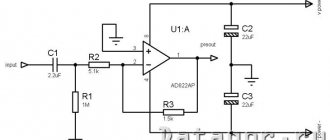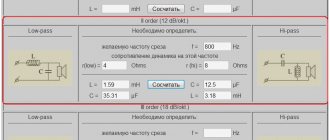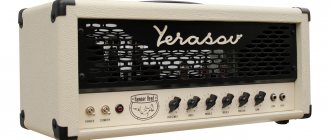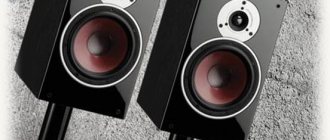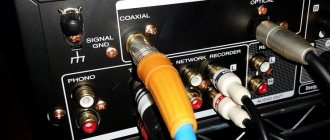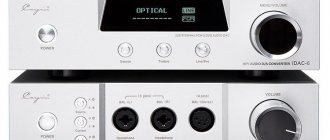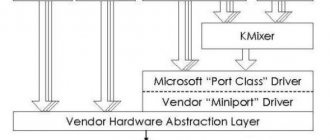miniDSP - digital sound processors
No, they didn't. No, they haven't changed it. No, we are not trolling Mizulina and Milonov. It would be necessary, but now there is no time, we have our own topic.
The emergence of a new brand, and even more so a new type of technology, quite often occurs in a pompous and ceremonious manner. “The Khabibulin and Sons company has become the official distributor...” In this case, there was no solemnity, as well as ceremonies. MiniDSP devices (as they write themselves) produced by the MiniDSP company (as they write when Word itself substitutes a capital letter for them) began to appear in the list of system components presented in our section of the same name back in 2014. That is, from installation practice to the high art of distribution. And that's how it was...
miniDSP, as many have probably already guessed (by the way - how?) are digital sound processors of small dimensions. They are developed and produced by a company registered in Hong Kong. Want to see the founder (in 2006) and the leader (since)? Please…
Here is the founder (and leader). With the typically Hong Kong name of Tony Rouget (Tony Rouget, if you search on Google).
In the photo, the founder and leader is hanging out with a soldering iron; the subject of the drawing is active monitors developed by Tony for his personal musical needs. But inside there is also miniDSP and advanced ICE Power amplifier modules. As for the needs of the public, Tony all started with the development of circuits and software for digital processors “at the request of workers” as a subcontractor for companies specializing in professional audio equipment. However, knowing better than anyone the potential inherent in his developments, the native of the south of France rightly concluded that all this could work with no less success at home and (here it is, the moment of truth) in the car.
What was the main thing about the inherent potential? The founder of the then new company spoke about this himself in an interview. This is strict adherence to the canons of professional audio in everything related to the quality of sound transmission, because they are strict with this; this is maximum flexibility in choosing configuration and functionality (which is also largely borrowed from the life of professional sound engineers); and this is with the greatest possible ease of use and transparency of control, something that audio has never been famous for (and never will be).
How did samples of his works come to us? As always, almost by accident.
There is one man living in Moscow, his name is Alexander Valentinovich Lysenko. Have you heard of this? That’s good, otherwise I was afraid that you knew Milonov, but this one... Well, oh well. Someone (now it doesn’t matter who, and I don’t even know) brought the master literally in his pocket a board (even without a case) with the dimensions of a pack of cigarettes, admitted that this thing had reduced his capital by about a hundred dollars and offered to try it, like she supposedly did.
The maestro is inquisitive beyond his years, so he didn’t send it, but tried it. And I was surprised that it works, it works correctly, and when working correctly, it doesn’t spoil the sound. The last combination of characteristics, it should be noted, is not typical for all digital processors and was especially noted.
This is what they brought then. This is the miniest of all miniDSPs: the 2x4 model. Two RCA inputs, four outputs.
When developing products, Tony (the founder and leader) focuses both on hardware designers who need a functional module for integration wherever they need, and on end users who need this module as a complete component of the system they are creating.
For the “final” ones, the same modules are placed in the case. Inputs-outputs, USB for control and power supply. At home, for this you need a network adapter in the “piglet-big-bunch” price category. And for food in the car (the founder is not wild, he understands everything)…
For power supply in a car, a special adapter is produced, which at the same time provides complete galvanic isolation.
That first miniDSP 2×4 kit was used (since it is such a mini-mini...) in an installation on a motorcycle, the test in combat conditions passed with flying colors, and soon, with the active participation, the purchase of a whole batch was organized, and even “in pickles” "in the form of extensions and hardware and software. At the same time, more powerful models were ordered for testing.
These are 2x8 and 8x8 formula processors that exist only in the “whale” format. It’s all here at once: balance, imbalance...
The target audience of these models is designers, and they are given additional freedom by body kit options for the main module. For example…
The VOL FP remote control unit allows for multi-channel (from 8 outputs) processors to select the configuration, input and adjust the output volume (Master Volume). Since this unit will certainly be somewhere nearby, it was supplemented with an IR receiver for control from the remote control (on the corner of the board on the right).
A very simple – analog – version of an external volume control, connected to the board (it says on it where to plug it in)
And here is a module that adds digital coaxial inputs, optics and XLR EBU to the analog inputs of multi-channel “whales”.
There are actually many more expansion modules; here we have mentioned those that are most applicable to car audio tasks. Other modules and blocks (interesting in themselves) were created for complex professional audio, but we, as was said, have our own theme...
The “thematic” product is a specialized C-DSP 6x8 processor. The first letter is from the foreign word Car. Here on board is everything that is common in the best car audio houses: such and such inputs, power supply for the on-board network, even with Remote “exhaust” for other devices, and what is especially important today is the ability to sum channels by input, that is, collect the divided signal of the car into a single whole for further processing.
In the eyes of the pioneer of new technology, the strength of the new products was that if individual components are available in stock (and the already mentioned interested parties are working hard on this), it is possible to set up a configuration for any specific project. The same pioneer claims that in terms of sound, direct comparison with the most famous processors of our time is in favor of miniDSP. This last one is what we bought it for, when the time comes we will confirm or deny it.
Now: what does miniDSP have on the software side? All software is supplied separately, so each device can be loaded with a program with the required configuration and functionality. For the simplest 2x4, for example, there are three versions of the software. Even the simplest one turns a baby into a serious instrument. Here, for example, is the ADVANCED 2×4 plugin:
Here, in particular, there is a crossover with filters up to 48 dB/oct., and with different characteristics.
Each of the two inputs has its own six-band parametric, when after the crossover the signal spreads across four output channels, each has its own equalizer, again parametric, again with six bands. With the ability to introduce correction not only pointwise, but also according to the “shelf” pattern. With another plugin (this is voluntary), the parametric equalizer turns into a 31-band graphic equalizer, and the architecture of the crossover filters changes.
One of the main distinguishing features of models with eight outputs (2x8 and 8x8) is the function of signal routing and mixing: where everything comes from and what is summed with what.
The same functionality is available in our specialized C-DSP 6×8.
We haven’t dealt with real samples yet (the day will come – we will, rest assured), but there are precedents for using miniDSP in very advanced installations, and there are already quite a few (then take a look for yourself, links below). And, judging by the available information, the mini has a great chance of becoming a trend of the season...
A PROPOS
Aston Martin DB 7 with minidSP 2x4
Subaru Forester with miniDSP 2x4
Jeep Grand Cherokee with miniDSP 8x8
Range Rover Sport with nanoDIGI 2x8 (this is also miniDSP)
Tags: miniDSP
UMIK-1 miniDSP
Calibrated USB measurement microphone for measuring your system parameters.
The UMIK-1 is an omnidirectional USB measurement microphone that provides plug & play acoustic measurement. From acoustic measurements to recording, this microphone delivers low noise and accurate results you can count on. Forget about driver installations, OS compatibility, and uncalibrated microphones. Umik-1 is a USB Audio Class 1 device, automatically recognized by all operating systems (Windows/Mac) and iPad with camera connection kit. To ensure accurate measurements, a unique calibration file is provided based on the serial number. In combination with the recommended acoustic measurement software, it is ideal for a plug & play measurement system.
Features: Windows / Mac / Linux All measurement programs Special features such as calibrated SPL measurement included in free Room EQ Wizard (REW) software Frequency response: 20 Hz - 20 kHz +/- 1 dB with calibration loaded USB Audio: USB interface Audio class 1.0 without drivers for Windows, Mac and Linux Product data sheet UMIK-1 UMIK-1 FAQ
Equipment:
1 x UMIK-1 microphone 1 x shielded USB cable (1.5 m) 1 x mini tripod 1 x foam windscreen
All UMIK-1 are calibrated using a unique calibration file. Additionally, a unique auto-generated 90-degree calibration file is provided for use with the nanoAVR DL.
The miniDSP team has built long-term relationships with the following leading software applications and is proud to present recommended software solutions:
REW: miniDSP worked with John Mulcahy to create even greater compatibility for the UMIK-1 inside REW! In the latest beta version of REW (v5.01 and above), the UMIK-1 is automatically recognized by the software and prompted for use when REW is launched with a microphone connected.
Dirac RCS: As a widely recognized reference in room correction with countless high-quality audio and automotive products, we are proud to have Dirac as part of our partners. Dirac RCS is available in two versions (stereo or multi-channel). Please refer to Dirac's website for more information.
Umik-1 on iPad: Our technical team is testing UMIK-1 along with several iPad applications. Plug & Play setup for full featured measurement + SPL meter works with iPad.
Fuzz Measure Pro v4: Fuzz Measure. This very powerful Mac-only software now fully integrates UMIK-1 calibration file import and automatic SPL calibration. Don't forget to check it out!
Amarra Symphony: Amarra Symphony with IRC is an advanced music player for the Apple Mac platform. It includes an Impulse Response Correction (IRC) feature that corrects acoustic errors at the listening position caused by early reflections from the speaker and listening room. It also provides the ability to tailor the response at the listening position using target curves.
Specification:
Capsule type and polar pattern 6 mm electret, omnidirectional
Frequency response 20 Hz - 20 kHz
USB Audio Class USB Audio class 1.0 Driverless interface for Windows, Mac and Linux
miniUSB connector
Unique microphone calibration - .txt file related to serial number includes axisFrequency Amplitude/Drift Sensitivity element
Resolution and sampling rate 24-bit ADC at 48 kHz
Max. SPL for 1% TDH at 1 kHz 133 dB SPL @OdB gain
Output noise level at max IGPA -74dBFS
Weight 120 g for microphone, 600 g complete set with accessories
USB powered (5V) - Blue LED indicates device is energized
Win/Mac Compatible ✔
